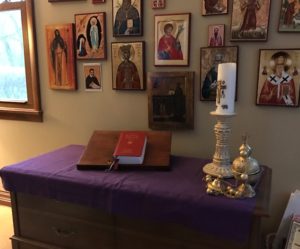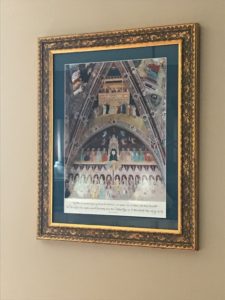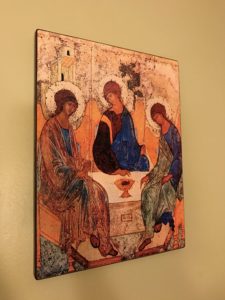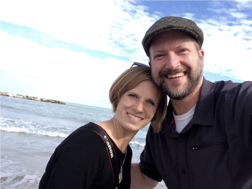A Graced Life in Christ
©2017 Steve and Marcia Mattern
Art asked us to share about how we integrate Charlotte Mason’s ideas with our Catholic faith. We initially thought it could be helpful to develop lists of citations and quotes from Catholic teachings and from Charlotte Mason, not to suggest an inorganic admixture of the two orientations, but rather to establish some points of intersection and shared/similar assumptions about God and the human person. But that work is for another time.
Instead of a scholarly article, we have simply put in “coffee table language” how we might respond to such a question if posed late night, at table, after a conference. When we have attended conferences specific to Charlotte Mason, we have enjoyed these chats “at table” with some conversations lasting far into the night. So this response is a kind of “virtual table chat” and is meant to be informal and very general.
So imagine with us that we are sitting at a large round table laughing, eating snacks, and drinking coffee. Someone asks, “How do you integrate Charlotte Masons ideas with your Catholic faith?”
 1. God’s Word in Sacred Scripture has a primary role in the ongoing formation of the adult and child both made in God’s image. Slow, attentive reading of Sacred Scripture for the sake of assimilating it wholly into one’s life, through mind and heart, is to be preferred over cold, rationalistic study of the Bible. The heart, mind, home, and classroom are places of encounter of this transforming Word that is the source of our growth. In the Catholic tradition, specific to Benedict of Nursia and his followers from 500 AD onward, we do a specific way of reading the Bible called Lectio Divina. The Internet abounds with resources of how to engage with this “sacred reading” approach.
1. God’s Word in Sacred Scripture has a primary role in the ongoing formation of the adult and child both made in God’s image. Slow, attentive reading of Sacred Scripture for the sake of assimilating it wholly into one’s life, through mind and heart, is to be preferred over cold, rationalistic study of the Bible. The heart, mind, home, and classroom are places of encounter of this transforming Word that is the source of our growth. In the Catholic tradition, specific to Benedict of Nursia and his followers from 500 AD onward, we do a specific way of reading the Bible called Lectio Divina. The Internet abounds with resources of how to engage with this “sacred reading” approach.
 2. The Church is an organic, living, sacramental extension of Our Lord Jesus Christ. The Christian lives the Mystery of Christ’s life through a Liturgical Cycle, or rhythm, throughout Advent, Christmas, Ordinary Time, Lent, Easter, and more special commemorations. The Church arranges for this living out of the life of Christ through graced time. Liturgical worship has a traditional form and shape for many reasons. Christ did not leave us. He is both in Heaven, but “God With Us” here, now. For our family the liturgical life is lived at home and at the church. We keep visual reminders of the time of the year through beautiful images and liturgical colors. Just as the year is divided into rhythms, our daily family prayer has specific times and a central place in our home. We have a ‘prayer corner’ around which we gather for our shared prayer times.
2. The Church is an organic, living, sacramental extension of Our Lord Jesus Christ. The Christian lives the Mystery of Christ’s life through a Liturgical Cycle, or rhythm, throughout Advent, Christmas, Ordinary Time, Lent, Easter, and more special commemorations. The Church arranges for this living out of the life of Christ through graced time. Liturgical worship has a traditional form and shape for many reasons. Christ did not leave us. He is both in Heaven, but “God With Us” here, now. For our family the liturgical life is lived at home and at the church. We keep visual reminders of the time of the year through beautiful images and liturgical colors. Just as the year is divided into rhythms, our daily family prayer has specific times and a central place in our home. We have a ‘prayer corner’ around which we gather for our shared prayer times.
3. Because the child is born a person in God’s image, our way of life itself is a consequence of this known truth. Beauty found both in nature and as created by man is a pathway to experience and encounter God. What God has created is good. Our family works to continually have eyes that see the goodness in others and in the created world around us. We find connection to Bartimaeus in the Gospels (especially the record in Mark 10:46-52) to be a good reminder to ask the Lord to open our eyes daily to the beauty He has provided for us. Think of the miracles we experience everyday. Do we see them?
 4. Miss Mason understands “how things are” in the order of creation. That is, her “ontology” is correct and aligned with truth. Therefore, her way of knowing about God, nature, and the human person is sound and secure (this is her “epistemology”). Miss Mason sees the sweeping and profound mysteries of Creation, Redemption in Christ, and the eventual Fulfillment of all in Christ not as beliefs about spiritual realities which are abstracted from our everydayness. These mysteries are part of our daily life, the warp and woof of daily experience and learning. In other words, just as the body, mind and spirit/soul are a composite, so too is the spiritual life of grace one with the experience of knowledge and wonder in the natural world.
4. Miss Mason understands “how things are” in the order of creation. That is, her “ontology” is correct and aligned with truth. Therefore, her way of knowing about God, nature, and the human person is sound and secure (this is her “epistemology”). Miss Mason sees the sweeping and profound mysteries of Creation, Redemption in Christ, and the eventual Fulfillment of all in Christ not as beliefs about spiritual realities which are abstracted from our everydayness. These mysteries are part of our daily life, the warp and woof of daily experience and learning. In other words, just as the body, mind and spirit/soul are a composite, so too is the spiritual life of grace one with the experience of knowledge and wonder in the natural world.
To put it another way, the modern world is marked by materialism (only matter ultimately matters), pragmatism (that which practically works matters most), and utilitarianism (what is most useful is that the greatest happiness for the maximum number of people is to be sought, but happiness is not defined). Today we can add that the influence of hedonism (my own sensory pleasure is of primary importance), nihilism (nothing is true or real), and scientism (belief in science vs. religion) have added more threats to establishing a correct understanding of God as He has revealed Himself and of the human person made in His image. Miss Mason saw the roots of these many threats even in her time and countered them with clear principles grounded in truth and Truth himself.
In the Catholic world view, there is a great parallel in many areas. We see both Charlotte Mason and Catholic tradition have a compatibility and alignment relative to these areas.
 Both orientations establish for us how one’s knowledge and experience of God become the central focus of one’s life. In grace we seek always to more fully know, love and worship God more intimately. There is a constant, sincere, humble striving to deepen our understanding of (1 Peter 2) our tasting/partaking in God. God so actively reveals Himself first in creation, then through His covenants, then through Redemption, and now through His presence with us. There is wonder, reverence, and deep awe regarding the nature of the child who is beautifully made in the image and likeness of God.
Both orientations establish for us how one’s knowledge and experience of God become the central focus of one’s life. In grace we seek always to more fully know, love and worship God more intimately. There is a constant, sincere, humble striving to deepen our understanding of (1 Peter 2) our tasting/partaking in God. God so actively reveals Himself first in creation, then through His covenants, then through Redemption, and now through His presence with us. There is wonder, reverence, and deep awe regarding the nature of the child who is beautifully made in the image and likeness of God.
Both orientations seek to affirm that a graced life in Christ is more than head or heart alone, but a total living out of a commitment. We seek to understand how best to live our life in Christ, as expressed in character formation and virtue. Put simply, as we more deeply experience Who God is, we can then go further in establishing a more authentic expression of how He seeks to be worshiped. However, the consequence of deepening understanding of both areas brings us to the moment of choice, moment by moment, of how we are then to live this Mystery of grace. In summary: a right understanding of Who God is forms the basis of how He is worshipped. These two aspects of Christian life are then ordered to how we are to live (moral and ethical choices). Finally from dogma, doctrine, liturgical theology, and moral living in Christ, we need prayer to flow. The organic wholeness and interconnectedness of orthodox doctrine, orthodox worship, orthodox moral and ethical life, and an authentic, intimate prayer life is one that buffers against subtle forms of dualistic thinking.
Both orientations value the gifts of atmosphere, discipline, and life. The Catholic experience highly values the establishment of daily habits of the spiritual life: abiding prayer, mental prayer, meditation, and contemplation. A mystery is not something we can know nothing whatsoever about but rather something we can know a great deal about but which we can never really know everything about. Human life and life in Christ have aspects of mystery. We need not be bored on our journey. Education is supportive of our formation, which does not end. Education is not ultimately oriented toward establishing a skill. It serves the formation of the human person and this formation is intellectual, human, personal, and spiritual.
Both orientations deeply respect the holy work of forming others and supporting their growth. Within the Catholic tradition, those who engage in the service of forming a child are doing a holy work which impacts the entire Body of Christ, indeed the whole world. The duty of parents in educating their children in the Lord has been widely emphasized in Sacred Scripture, through writings of Church Fathers, and by prominent leaders within the Catholic tradition over the past 2000 years. Charlotte Mason encouraged ongoing formation of her teachers after they left Scale How through papers, letters, and writings. Her poetic study of the gospels, her meditations, and even hand-written letters inspire us as educators to never stop learning.
 Both orientations for learning, Catholic and Charlotte Mason, support the great reverence and respect for God’s creation — especially its crown jewel, the human person. Neither of these see that nature is ruined and only waiting for the end — Heaven. They both see God’s creation as good and as a way to see God’s fingerprints in a real way. Therefore both the role of wonder and reverence and the joy of discovery are enabled in both orientations. In neither educational systems are utilitaristism, pragmatism, or materialism seen as good for the human person. In fact, they are poisonous to the person, the family, the nation, and the Church.
Both orientations for learning, Catholic and Charlotte Mason, support the great reverence and respect for God’s creation — especially its crown jewel, the human person. Neither of these see that nature is ruined and only waiting for the end — Heaven. They both see God’s creation as good and as a way to see God’s fingerprints in a real way. Therefore both the role of wonder and reverence and the joy of discovery are enabled in both orientations. In neither educational systems are utilitaristism, pragmatism, or materialism seen as good for the human person. In fact, they are poisonous to the person, the family, the nation, and the Church.
In both orientations, learning is joyfully engaged within the Christian community vs. being obtained alone. God Himself is a Community of Three Persons and we are hard-wired in the image of this God to seek and to enjoy communion with others. The life of God’s grace living and growing within the life of the child is seen as wonderful and so very good.
Finally, they both point to our final end (purpose), Heaven, and they both point to the acquisition of knowledge and the fullness of joy in knowing the truths and the Truth along the way to God. The lives of saints whose lives give abiding witness to God’s ways of growing and forming us represent a form of education for us. What God does in these men and women, He still does in our midst, now: He equips and sanctifies His beloved children by dwelling in and with them. In this, grace is not a thing but rather the very presence of God in us, making us more brightly into his likeness, step by step.
What a joyful journey both give witness to! We see this as walking alongside our children on this journey towards God.
Thank you, Art, for inviting us to this table.
Note: For more wondering and research, consider using the searchable Catholic Catechism. We found these words to give many points of connection: God, Christ, Person, Virtue, Truth. You may also wish to discover Charlotte Mason’s writings and library on these topics at the Digital Collection.
 You can find Steve and Marcia Mattern on their homestead in rural central Illinois. They have been homeschooling their six children with a Charlotte Mason philosophy and methodology since the beginning. Their oldest child completes her high school journey in May 2017. With six kids — three boys and three girls, and a managerie of chickens, goats, ducks, cats, dogs, and bees — their hobby farm is far from quiet.
You can find Steve and Marcia Mattern on their homestead in rural central Illinois. They have been homeschooling their six children with a Charlotte Mason philosophy and methodology since the beginning. Their oldest child completes her high school journey in May 2017. With six kids — three boys and three girls, and a managerie of chickens, goats, ducks, cats, dogs, and bees — their hobby farm is far from quiet.
Steve serves as Senior Vice President of Mission Service for OSF Health Care in Peoria, Illinois. He holds a BA in Philosophy from St. Mary’s University of Minnesota, a MA in Human Development Counseling from Bradley University, Illinois, and a MA in Theological Studies from St. Meinrad in Indiana. Steve worked as a Licensed Clinical Professional Counselor in a Christian outpatient practice for 8 years. Steve has published works on relationships, virtues, and fatherhood.
Marcia has been a Registered Dietitian since 1997 and a Professional Birth Doula since 2004. Marcia established the first Atrium for Catechesis of the Good Shepherd in Peoria in 2001 and continues to lead it. Both she and Steve serve as Catechists in the Atrium. They volunteered as Natural Family Planning teachers for 10 years for the Diocese of Peoria. They are happy to share their love of the outdoors, traveling and well written books. Be sure to visit Marcia’s blog.
3 Replies to “A Graced Life in Christ”
Beautifully articulated, Marcia and Steve! And thank you, Art, for sharing the Matterns with us!
Thanks for chatting with us. I’ll take a little more coffee, please. 😉 I love hearing how CM beautifully plays out in different family’s lives. I love all the photographs of the beautiful art in your home. 🙂
Beautiful post, thank you. I would love to see more Catholic families embracing Mason’s philosophy of education. I too have found it to be such a natural and beautiful fit.